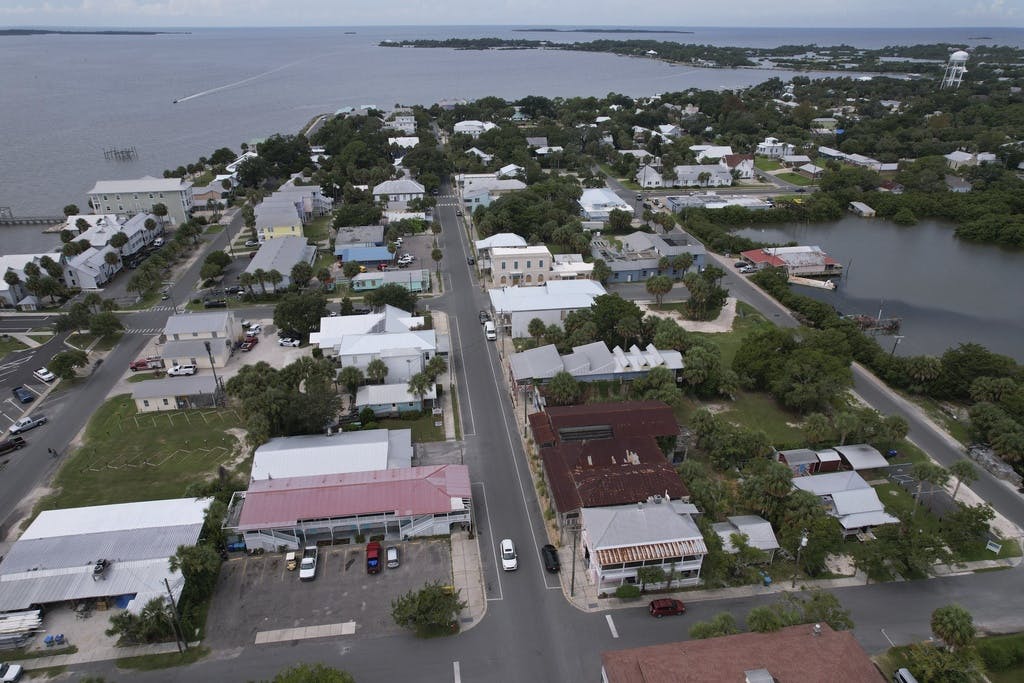Idalia Strengthens to Category 4 Hurricane as Storm Nears Florida Coast Amid Warnings of ‘Catastrophic’ Surge
Florida residents living in vulnerable coastal areas are ordered to pack up and leave.

CEDAR KEY, Florida — Hurricane Idalia strengthened to a dangerous Category 4 storm Wednesday morning as it steamed toward Florida’s Big Bend region and threatened to unleash life-threatening storm surges and rainfall.
Florida residents living in vulnerable coastal areas were ordered to pack up and leave as Hurricane Idalia gained strength in the warm waters of the Gulf of Mexico, and authorities warned of a “catastrophic storm surge and destructive winds” when the storm moves ashore later Wednesday morning.
Idalia was projected to come ashore as a Category 4 storm with sustained winds of at least 130 mph in the lightly populated Big Bend region, where the Florida Panhandle curves into the peninsula.
The result could be a big blow to a state still dealing with lingering damage from last year’s Hurricane Ian. It had grown into a Category 2 system on Tuesday afternoon and became a Category 3 just hours earlier Wednesday.
The National Weather Service in Tallahassee called Idalia “an unprecedented event” since no major hurricanes on record have ever passed through the bay abutting the Big Bend.
Hurricanes are measured on a five category scale, with a Category 5 being the strongest. A Category 3 storm is the first on the scale considered a major hurricane and the National Hurricane Center says a Category 4 storm brings “catastrophic damage.”
At 5 a.m. EDT Wednesday, Idalia was about 60 miles west of Cedar Key and 90 miles south of Tallahassee, the National Hurricane Center said. It was moving north at 18 mph.
On the island of Cedar Key, Commissioner Sue Colson joined other city officials in packing up documents and electronics at City Hall on Tuesday. She had a message for the almost 900 residents who were under mandatory orders to evacuate.
More than a dozen state troopers went door to door warning residents that storm surge could rise as high as 15 feet.
“One word: Leave,” Colson said. “It’s not something to discuss.”
Governor DeSantis repeated the warning at a Tuesday afternoon news conference.
“You really gotta go now. Now is the time,” he said. Earlier, the governor stressed that residents didn’t necessarily need to leave the state, but should “get to higher ground in a safe structure.”
Not everyone was heeding the warning. The owner of the Island Hotel, Andy Bair, said he intended to “babysit” his bed-and-breakfast, which predates the Civil War. The building has not flooded in the almost 20 years he has owned it, not even when Hurricane Hermine flooded the city in 2016.
Tolls were waived on highways out of the danger area, shelters were open and hotels prepared to take in evacuees. More than 30,000 utility workers were gathering to make repairs as quickly as possible in the hurricane’s wake. About 5,500 National Guard troops were activated.
In Tarpon Springs, a coastal community northwest of Tampa, 60 patients were evacuated from a hospital out of concern that the system could bring a 7-foot storm surge.
After landing in the Big Bend region, Idalia is forecast to cross the Florida peninsula and then drench southern Georgia and the Carolinas on Thursday. Both Governors Kemp of Georgia and McMaster of South Carolina announced states of emergency, freeing up state resources and personnel, including hundreds of National Guard troops.
“We’ll be prepared to the best of our abilities,” said Russell Guess, who was topping off the gas tank on his truck at Valdosta, Georgia. His co-workers at Cunningham Tree Service were doing the same. “There will be trees on people’s house, trees across power lines.”
Idalia pummeled Cuba with heavy rains on Monday and Tuesday, leaving the tobacco-growing province of Pinar del Rio underwater and many of its residents without power. State press did not report any deaths or major damage.
With a large stretch of Florida’s western coast at risk for storm surges and floods, evacuation notices were issued in 22 counties, with mandatory orders for some people in eight of those counties.
Many school districts along the Gulf Coast were to be closed through at least Wednesday. Several colleges and universities also closed, including the University of Florida in Gainesville. Florida State University in Tallahassee said its campus would be closed through Friday.
Two of the region’s largest airports stopped commercial operations, and MacDill Air Force Base on Tampa Bay sent several aircraft to safer locations.
Asked about the hurricane Tuesday, President Biden said he had spoken to Mr. DeSantis and “provided him with everything that he possibly needs.”
